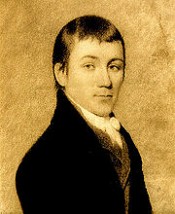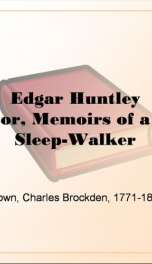Brown Charles Brockden

Charles Brockden Brown (January 17, 1771 – February 22, 1810), an American novelist, historian, and editor of the Early National period, is generally regarded by scholars as the most ambitious and accomplished US novelist before James Fenimore Cooper. He is the most frequently studied and republished practitioner of the "early American novel," or the US novel between 1789 and roughly 1820. Although Brown was by no means the first American novelist, as some early criticism claimed, the breadth and complexity of his achievement as a writer in multiple genres (novels, short stories, essays and periodical writings of every sort, poetry, historiography, reviews) makes him a crucial figure in US literature and culture of the 1790s and 1800s, and a significant public intellectual in the wider Atlantic print culture and public sphere of the era of the French Revolution. Brown was born on January 17, 1771,[1] the fourth of five brothers and seven surviving siblings total in a Philadelphia Quaker merchant family. His father Elijah Brown, originally from Chester County, Pennsylvania, just southwest of Philadelphia, had a variable career primarily as a land-conveyancer or agent in real estate transactions. The two oldest brothers, Joseph and James, and youngest brother Elijah, Jr., were import-export merchants and bought shares in re-export ventures as early as the 1780s. Brown became a reluctant partner of their short-lived family re-export firm, James Brown & Co., from late 1800 to the firm's dissolution during 1806. The third brother, Armitt, was a clerk for the Treasury department and at the Bank of Pennsylvania (for a time Armitt was a clerk with Alexander Hamilton). The family's mercantile background and experiences in the global trade and trade conflicts of the revolutionary era are relevant to Brown's writings insofar as he often explores issues connected to the period's culture of commerce and the role that commerce plays in the historical transition from eighteenth-century civic republicanism to nineteenth-century laissez-faire liberalism, capitalism, and imperialism. Brown's family intended for him to become a lawyer. After six years in Philadelphia at the law office of Alexander Wilcocks, he ended his law studies during 1793.[2] He became part of a group of young, New York-based intellectuals who helped begin his literary career. The New York group included a number of young male professionals who called themselves the Friendly Club (including Dr. Elihu Hubbard Smith, Brown's closest friend during this period, and William Dunlap), along with female friends and relatives who were interested in companionship and cultural-political conversation. During most of the 1790s, Brown developed his literary ambitions in projects that often remained incomplete (for example the so-called "Henrietta Letters," transcribed in the Clark biography) and frequently used his correspondence with friends as a sort of laboratory for narrative experiments. His first publications appeared during the late 1780s (e.g. "The Rhapsodist" essay series from 1789), but generally he published little during this period. By 1798, however, these formative years gave way to a period of novel-writing during which Brown published the titles for which he is known best nowadays. In complex ways, these novels and the rest of Brown's career are informed by the progressive ideas he uses and develops from the period's British radical-democratic writers, most notably Mary Wollstonecraft, William Godwin, Thomas Holcroft, and Robert Bage. Brown was influenced by these writers and in turn exerted an influence on them and their younger studiers, for example in Godwin's later novels, or in the work of Percy Bysshe Shelley and Mary Shelley, who reread Brown as she wrote her novels Frankenstein; or, The Modern Prometheus (1818) and The Last Man (1826). During the novelistic phase that lasts from 1798 until late 1801, Brown published the Wollstonecraftian-feminist dialog Alcuin (1798), and seven subsequent novels. An additional novel was written, but was lost by a series of mishaps and consequently never saw publication. In addition to his output of novels, Brown also became an editor during this period and, along with his friends in New York published and wrote many short articles and reviews for The Monthly Magazine and American Review from April 1799 to December 1800, as well as its short-lived successor, The American Review and Literary Journal (1801-1802). Finally, besides these two New York periodicals, Brown also published numerous fictional pieces, including the only surviving fragment of his first novel Sky-Walk, in the Philadelphia-based Weekly Magazine of Original Essays, Fugitive Pieces, and Interesting Intelligence (1798-1799). Brown's novels are often characterized simply as gothic fiction, although the model he develops is far from the Gothic romance mode of writers such as Ann Radcliffe. Brown's novels combine several revolutionary-era fiction subgenres with other types of late-Enlightenment scientific and medical knowledges. Most notably, they develop the British radical-democratic models of Wollstonecraft, Godwin, and Holcroft and combine these with elements of German "Schauer-romantik" gothic from Friedrich Schiller, the enlightened sentimental fictions of Jean-Jacques Rousseau or Laurence Sterne, women's domestic novels by writers such as Fanny Burney or Hannah Webster Foster, and other genres such as captivity narrative. Brown builds plots around particular motifs such as sleepwalking and religious mania, drawing on Enlightenment-era medical writings by people such as Erasmus Darwin. Of the seven novels extant, the first four to be published in book form (Wieland, Ormond, Edgar Huntly, and Arthur Mervyn) have received the lion's share of commentary and attention. Because of their sensational violence, dramatic intensity, and intellectual complexity, these four novels are often referred to as the "gothic" or "Godwinian" novels. Stephen Calvert, which appeared only in serialized form and in the posthumous 1815 biography, remained little-read until the end of the twentieth century, but is notable as the first US novel to thematize same-sex sexuality. Clara Howard and Jane Talbot have been regarded sometimes as relatively conventional works distinct from the earlier novels because they have classic epistolary form and concern domestic issues that seem very different from the violence and sensationalism of the first four novels. Recent scholarship (since the 1980s), however, has largely revised this view and emphasizes the continuities and overall coherence of all seven novels understood as a loosely unified ensemble. Brown articulates a well-defined technique and plan for his novel-writing in essays such as "Walstein's School of History" (1799) and "The Difference Between History and Romance" (1800). In these essays, he explains that his novels combine fiction and history to place ordinary individuals (like his novelistic protagonists Arthur Mervyn or Edgar Huntly) into situations of historical stress (like the Yellow Fever epidemic of 1793 or settler-Indian violence on the Pennsylvania frontier after the Walking Purchase) in such a way as educate his audience about virtuous behaviors and the historical causes and conditions of individual actions. In short, Brown uses his Wollstonecraftian-Godwinian models to develop political fiction that is intended to educate his readers and to be part in the ideological and cultural debates of his period. Brown's life-long support for feminism, for example, originates both from his Quaker background, and from his commitment to the late-Enlightenment ideals of the revolutionary era. While crucial aspects of Brown's overall orientation and novelistic method are adapted from the British Wollstonecraftian-Godwinian writers, it is important to note that he was no mere imitator of his sources, but an independent thinker who advanced and refined their ideas and techniques as he adopted them. Brown shares with the British radical-democrats an emphasis on sociocultural determinism and on the use of literature as a medium for spreading progressive ideas. In addition, he shares with Godwin, in particular, the project of combining historical and fictional modes into a distinctive and progressive narrative style designed to stimulate social awareness and action. But he advances their models, for example, by placing a new emphasis on the culture and contradictions of economic liberalism and the world of commerce, focusing on a crucial topic that his British novelistic sources minimized, but which would grow exponentially in importance throughout the post-revolutionary era. It is also significant that Brown examines issues associated with personal identity (race, gender and sexuality, etc.) in ways that the British radical-democratic novelists did not, primarily by associating them with larger issues of social and economic power in the new liberal order that was emerging at the turn of the nineteenth century. As Brown undicates in the "Walstein's School of History" essay, two primary topics of drama of his novelistic plots are "sex" (or gender relations) and "property" (or economic relations). After 1801 Brown continued to publish prolifically. He authored several important political pamphlets arguing for the acquisition of the Louisiana Territory and against the Embargo Act of 1807. He edited and was primary contributor to two more magazines: The Literary Magazine and American Register (1803-1806), a miscellany on cultural and other topics (from geography and medicine to history and aesthetics) and The American Register and General Repository of History, Politics, and Science (1807-09). The latter is notable for the book-length "Annals of Europe and America," Brown's contemporary historical narrative of Napoleonic geopolitics. Brown continued to write fiction and experiment with other literary genres during this period, notably in the Historical Sketches, a group of historical fictions that were written between 1803 and 1807 but published only posthumously. These late experimental narratives show Brown exploring the interface of fiction and history at the end of the revolutionary era, at a moment that both follows the great Enlightenment historians (e.g., David Hume, William Robertson (historian), Edward Gibbon) and prefigures the emergence of the nineteenth-century historical romance form in writers like Walter Scott or James Fenimore Cooper. He also published miscellaneous pieces in other Philadelphia newspapers and magazines of the 1800s including the Aurora and, in 1809, the Port-Folio.
do you like this author?
What readers are saying
What do you think? Write your own comment on this book!
write a commentWhat readers are saying
What do you think? Write your own comment on this author!
write a commentBook list

edgar huntleyor memoirs of a sleep walker
Series:
Unknown
Year:
Unknown
Raiting:
1/5
This book was converted from its physical edition to the digital format by a community of volunteers. You may find it for free on the web. Purchase of the Kindle edition includes wireless delivery.
Show more
add to favoritesadd In favorites

Wieland: or, the Transformation, an American Tale
Series:
Unknown
Year:
Unknown
Raiting:
2.5/5
Show more
add to favoritesadd In favorites

Jane Talbot
Series:
Unknown
Year:
Unknown
Raiting:
4.5/5
Originally published in 1887. This volume from the Cornell University Library's print collections was scanned on an APT BookScan and converted to JPG 2000 format by Kirtas Technologies. All titles scanned cover to cover and pages may include marks notations and other marginalia present in the original volume.
Show more
add to favoritesadd In favorites
What readers are saying
What do you think? Write your own comment on this author!
write a commentGenre
- Books
- Books / Children's Books
- Religion & Spirituality / Christianity / Protestantism / Calvinist
- Religion & Spirituality / Christianity / Literature & Fiction / Fiction
- Books / Different genres / Horror
- Books / Different genres / Horror / Authors, A-Z
- Law / United States
- Books / Russo-Japanese War, 1904-1905
- Literature & Fiction / Authors, A-Z / ( M ) / Malory, Sir Thomas
if you like Brown Charles Brockden try:
readers also enjoyed
What readers are saying
What do you think? Write your own comment on this author!
write a commentGenre
- Books
- Books / Children's Books
- Religion & Spirituality / Christianity / Protestantism / Calvinist
- Religion & Spirituality / Christianity / Literature & Fiction / Fiction
- Books / Different genres / Horror
- Books / Different genres / Horror / Authors, A-Z
- Law / United States
- Books / Russo-Japanese War, 1904-1905
- Literature & Fiction / Authors, A-Z / ( M ) / Malory, Sir Thomas
if you like Brown Charles Brockden try:
readers also enjoyed
Do you want to exchange books? It’s EASY!
Get registered and find other users who want to give their favourite books to good hands!

